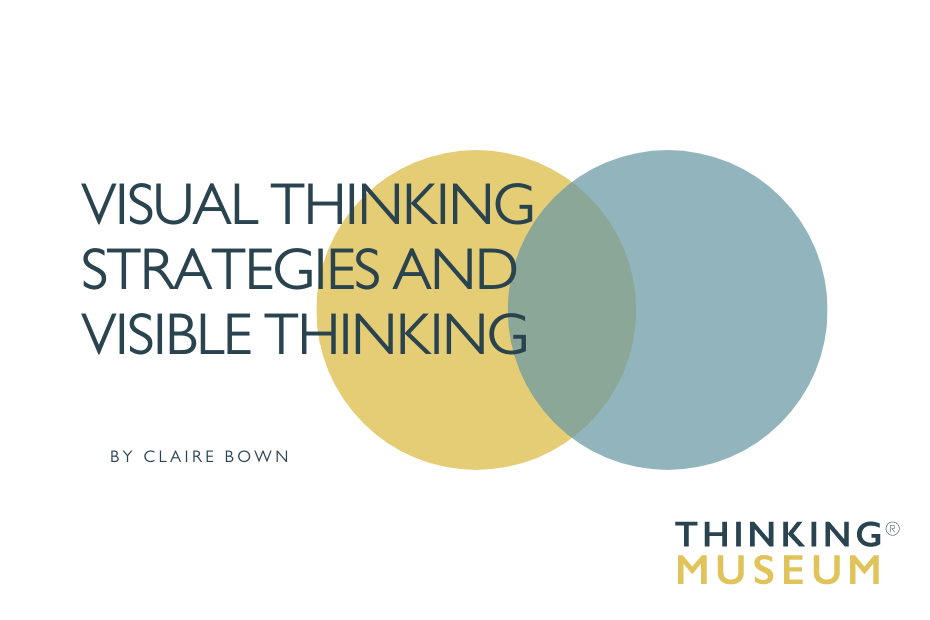Visible Thinking and Visual Thinking Strategies (VTS) often get confused. Here are some of the differences and similarities between the two frameworks. So, deep breath, here we go…
Visual Thinking Strategies
Visual Thinking Strategies (VTS) is an organisation, a facilitation method, and a professional development programme based on more than 30 years of collaboration between cognitive psychologist Abigail Housen, veteran museum educator Philip Yenawine, and their colleagues.
As a facilitation method and approach, VTS focuses on looking and discussing works of art mediated by a discussion facilitator. VTS is based around a protocol of three carefully constructed open-ended questions which are strictly and rigorously adhered to:
- What’s going on in this picture?
- What do you see that makes you say that?
- What else can you find?
The first question (‘What’s going on in this picture?’) aims to open up the discussion and invites a variety of comments ranging from colours, information and shapes to feelings. This first question probes directly for meaning, rather than prompting for a list of observations. Also of note, it is only asked once during the discussion. Many other strategies – such as, for example, Edmund Feldman’s ‘Formal Analysis’, Terry Barrett’s ‘Critical Response’ Method, and many of the Visible Thinking routines – emphasise the importance of making observations before jumping into interpreting the object or art work. To my mind, time spent observing is valuable in order to avoid hasty judgements or interpretations.
As the discussion develops, the facilitator asks the second VTS question ‘What do you see that makes you say that?’ which asks the students to provide evidence to back up their interpretations. The final question ‘What more can you/we find?’ has the goal of making the discussion more rounded.
VTS was developed as an alternative to formal art analysis in which art historical concepts are often beyond the young or inexperienced observer’s understanding. It has been groundbreaking in the fact that it encourages people to discover and voice their own personal meanings to works of art in a slow and careful way (sometimes 15-30 minutes at one art work).
VTS is a specific and thorough method with a curriculum that spells out exactly what is to be shown, at what age, and in what order. Facilitators are taught to point to what the students are talking about in the art and to paraphrase every comment made. Facilitators are also required to remain neutral throughout and not to add any contextual or factual information. (NOTE: this has been updated in recent years. VTS now ask facilitators to be open and accepting rather than ‘neutral’).
VTS was something of an inspiration for the team at Project Zero who spent a year evaluating VTS at the Museum of Modern Art (MoMA) in New York. This was their first exposure to a thinking routine and Shari Tishman and David Perkins have since named VTS as one of three projects that were formative in shaping and helping to develop Visible Thinking. ‘What makes you say that?’ is listed as one of the core thinking routines, although its delivery differs somewhat from the structure imposed by the VTS method.
In a nutshell, when we talk about the differences between VTS and Visible Thinking, the basic point to remember is that VTS uses the original ‘thinking routine’, and that the method uses only this one routine based on 3 simple questions.
Visible Thinking
Visible Thinking, is a research project (from Project Zero) that worked in partnership with schools and developed more than 41 thinking routines (there are more than 100 thinking routines in total if you add other thinking routines from other PZ projects) alongside a range of other practices such as documentation. The thinking routines can be used specifically according to the type of thinking that you wish to elicit. There are routines for introducing and exploring, for synthesising and organising and for digger deeper into ideas. For those getting started with Visible Thinking, See Think Wonder is a wonderful routine that focuses on careful observations, thoughtful interpretations and stimulates curiosity:
- What do you see?
- What do you think is going on?
- What does it make you wonder?
Whilst VTS was developed in a museum context, Visible Thinking became what it is today through classroom practice and development. Both have crossed over into other environments, VTS has developed the VTS School Program and Visible Thinking has been used in many museum educational programmes. Used in the museum, Visible Thinking routines are a powerful questioning framework that educators can use to facilitate inquiry-based discussions that engage participants in discussion and exploration.
There are similarities and differences between these two approaches but ultimately, they both embrace a new way of thinking and learning. Both frameworks lead to fundamental changes in the way educators facilitate their programmes in the museum and the way audiences engage with artworks and objects.
Sign up for my Curated newsletter
Every other Friday I share a small dose of curated inspiration. It might be things I’ve read, things I’ve listened to or things I’ve watched.
Hear about my latest podcast episode and read useful tips, recommendations and things that I love. Join via the button below.

Pingback: Information Overload: How much is too much? | thinking museum
I trained in VTS years ago and just learned about Visible Thinking. Thank you for explaining their relationship to each other.
Good to hear it!